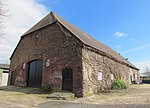Duiven railway station
1856 establishments in the NetherlandsDuivenDutch railway station stubsRailway stations in GelderlandRailway stations in the Netherlands opened in 1856 ... and 2 more
Railway stations in the Netherlands opened in the 19th centuryRailway stations on the Rhijnspoorweg

Duiven is a railway station located in Duiven, Netherlands. The station was opened on 15 February 1856 and is located on the Oberhausen–Arnhem railway between Arnhem and Elten (Germany). The train services at this station are operated by Arriva and Breng. The station was closed on 4 October 1936, but reopened on 31 May 1980. ICE services pass through this station at high speed.
Excerpt from the Wikipedia article Duiven railway station (License: CC BY-SA 3.0, Authors, Images).Duiven railway station
Parallelweg, Duiven
Geographical coordinates (GPS) Address Nearby Places Show on map
Geographical coordinates (GPS)
| Latitude | Longitude |
|---|---|
| N 51.943333333333 ° | E 6.0141666666667 ° |
Address
Station Duiven
Parallelweg
6922 HH Duiven
Gelderland, Netherlands
Open on Google Maps







